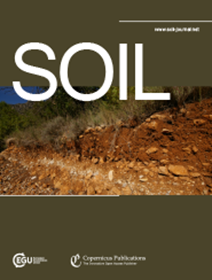基于自动SfM摄影测量制图方法的单坡高空间分辨率近连续观测土壤表面变化
IF 4.3
2区 农林科学
Q1 SOIL SCIENCE
引用次数: 0
摘要
摘要。土壤侵蚀是一个主要的全球威胁,有必要详细了解其时空动态。先进的地理空间技术,如延时运动结构(SfM)摄影测量,提供了对地表变化的高分辨率监测。本研究提出了一种新的事件驱动方法,用于在多年周期内近连续监测山坡表面动态。该系统在三个斜坡站使用同步数码单反相机,由雨量计和每日计时器触发。对地面控制点(gcp)进行了毫米精度的测量,以确保精确的地理参考。开发了一种基于python的自动化工作流程,用于同步图像,使用卷积神经网络(CNN)检测gcp,通过SfM生成每日数字3D表面模型,并计算3D表面差异模型(DoDs)。SfM点云的绝对精度平均在8 ~ 12 mm之间,主要是由于配准误差,偏差较低(<;高度调整后中央区域为5 mm)。相对精度随距离相机的远近而下降,根据距离和位置的不同,探测水平(LoD)值在5毫米到25毫米之间。时间序列分析揭示了由降雨、融雪和农业活动驱动的地表变化。最显著的变化往往发生在耕作后不久,即使降雨量很少,表明侵蚀和非侵蚀过程。在耕作后的前7天内,降雨量与海拔损失呈显著负相关。冬季地表季节性下降3 ~ 5 cm,偶尔因霜冻或植被生长而出现正变化。监测系统和工作流程是可转移的,由此产生的高分辨率数据集对于分析侵蚀动力学和验证土壤侵蚀模型非常有价值。本文章由计算机程序翻译,如有差异,请以英文原文为准。
Near-continuous observation of soil surface changes at single slopes with high spatial resolution via an automated SfM photogrammetric mapping approach
Abstract. Soil erosion represents a major global threat, necessitating a detailed understanding of its spatial and temporal dynamics. Advanced geospatial technologies such as time-lapse structure-from-motion (SfM) photogrammetry provide high-resolution monitoring of surface changes. This study presents a novel event-driven approach for near-continuous monitoring of hillslope surface dynamics over a multi-annual period. The system employed synchronized DSLR (digital single-lens reflex) cameras at three slope stations, triggered by a rain gauge and a daily timer. Ground control points (GCPs) were surveyed with millimeter accuracy to ensure precise georeferencing. An automated Python-based workflow was developed to synchronize images, detect GCPs using a convolutional neural network (CNN), generate daily digital 3D surface models via SfM, and compute 3D surface models of difference (DoDs). The absolute accuracy of SfM point clouds ranged between 8 mm and 12 mm on average, primarily due to registration errors, with lower deviations (< 5 mm) in central areas after height adjustment. Relative accuracy decreased concentrically with distance from the cameras, with level of detection (LoD) values between 5 mm and 25 mm depending on distance and location. Time series analysis revealed surface changes driven by rainfall, snowmelt, and agricultural activity. The most significant changes often occurred shortly after tillage, even with minimal rainfall, indicating both erosional and non-erosional processes. A strong negative correlation between rainfall and elevation loss was especially evident within the first seven days following tillage. Seasonal surface lowering of 3–5 cm during winter and occasional positive changes due to frost or vegetation growth were also observed. The monitoring system and workflow are transferable, and the resulting high-resolution datasets are valuable for analyzing erosion dynamics and validating soil erosion models.
求助全文
通过发布文献求助,成功后即可免费获取论文全文。
去求助
来源期刊

Soil
Agricultural and Biological Sciences-Soil Science
CiteScore
10.80
自引率
2.90%
发文量
44
审稿时长
30 weeks
期刊介绍:
SOIL is an international scientific journal dedicated to the publication and discussion of high-quality research in the field of soil system sciences.
SOIL is at the interface between the atmosphere, lithosphere, hydrosphere, and biosphere. SOIL publishes scientific research that contributes to understanding the soil system and its interaction with humans and the entire Earth system. The scope of the journal includes all topics that fall within the study of soil science as a discipline, with an emphasis on studies that integrate soil science with other sciences (hydrology, agronomy, socio-economics, health sciences, atmospheric sciences, etc.).
 求助内容:
求助内容: 应助结果提醒方式:
应助结果提醒方式:


